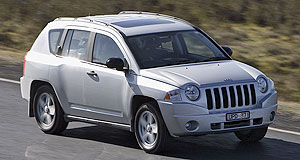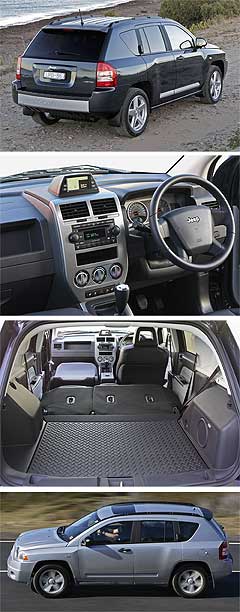First drive: Compass treads new ground for Jeep
BY BYRON MATHIOUDAKIS | 20th Mar 2007

Targeting the Toyota RAV4 and company is the Jeep Compass, a car-based part-time five-seater 4WD wagon that – along with its virtually identical-underneath Patriot sibling (due mid-year) – thrusts the American off-road icon deep into an unfamiliar urban war zone.
On sale now, two models are offered – the Compass Sport from $32,490 and the Compass Limited starting at $36,490 – fitted with ESP stability control as standard and presenting two transverse-mounted engine choices.
The mainstay powerplant is a new 2.4-litre twin-cam 16-valve four-cylinder petrol engine featuring dual variable valve timing.
It delivers 125kW of power at 6000rpm and 220Nm of torque 4500rpm, and is paired to either a five-speed manual gearbox or a CVT Continuously Variable Transmission the Americans call "AutoStick".
Drivers of the Dodge Caliber 2.4 will recognise this unit, which has been co-developed with Mitsubishi and Hyundai as part of DaimlerChrysler’s GEMA Global Engine Manufacturing Alliance.
Able to bound from zero to 100km/h in 10.7 seconds (CVT: 11.3), the Compass 2.4’s combined urban cycle fuel consumption figure is 8.7 litres per 100km (CVT: 9.5) while its carbon dioxide output is 206 and 226g/km respectively.
Astoundingly, the Compass is the first car-based compact SUV to offer a diesel option in Australia.
Using a variation of rival Volkswagen’s ubiquitous 2.0-litre twin-cam 16-valve four-cylinder TDI turbo-diesel powerplant, the misleadingly named CRD (it’s not a common-rail diesel, although the Chrysler Group seem to use this acronym for all its derv-driven products) pumps out 103kW at 4000rpm and 310Nm from 1750 to 2000rpm.
It beats the petrol engine for combined-cycle economy (6.5L/100km) and reduced carbon dioxide pollution (177g/km), and even pips the 2.4 CVT to the 100km/h sprint post by 0.3 seconds.
But choosing CRD adds a hefty $4000, and leaves you with no choice but a six-speed manual gearbox – with no automatic transmission is in the pipeline for now, according to Chrysler Group Australia managing director Gerry Jenkins, although he would dearly love to offer one.
The engines are not the only components that the Compass shares either.
It uses a development of the Mitsubishi GS/Chrysler JS transverse-engine platform also underpinning the recently released Caliber hatchback and Mitsubishi ZG Outlander SUV, and upcoming Chrysler Sebring and Dodge Avenger mid-sized duo as well as the next Mitsubishi Lancer small car – to name just a few.
So the monocoque Compass eschews the 4x4 ladder-frame chassis construction – another first for Jeep – meaning it has very limited off-road capabilities despite boasting a Cherokee-like proboscis and a respectable-in-class approach angle of 21 degrees, departure angle of 32 degrees and breakover angle of 20 degrees.

As with the X-Trail, a dash-switchable 4WD lock mode exists via a centre coupling when permanent 50:50 front/rear 4WD is needed. There is no 2WD lock.
The Compass’ independent suspension system is standard compact SUV fare – MacPherson struts up front and a multi-link rear arrangement – while a hydraulically powered rack-and-pinion steering set-up delivers a turning circle of 10.8 metres.
Wheels and tyres are 215/60 R17 on the Sport, complete with a full-sized spare, while a space-saver serves the 215/55 R18-shod Limited.
On the safety front, four-wheel disc brakes, traction control, Brake Assist, Electronic Roll Mitigation, anti-lock brakes with programming that can detect rough-road surfaces, and dual front and side-curtain airbags join the Compass’ standard stability control specification.
Lowering the split/folding and reclining rear seats and folding the front passenger seat onto itself boosts luggage space from 738 litres to 1277 litres. Braked towing capacity is 1500kg and the car’s kerb weight ranges from 1460kg to 1585kg.
Depending on which model is chosen, you might find novelties like speakers that flip down when the tailgate is raised (for a spot of outdoors karaoke), a detachable torch incorporated into the roof’s lining, a sliding front-centre armrest with MP3 or mobile phone storage, a removable and washable vinyl cargo floor, and soil-repellent and anti-bacterial seat fabric called ‘YES Essentials’ that resists odours and dirt.
All models come with air-conditioning, powered windows, mirrors and door locks with remote entry, plus three rear ISOFIX latches, cruise control, foglights, an alarm and roof-rack side rails, while the Limited adds leather trim, heated front seats and larger wheels, among other items.
While expanding the brand downwards, Jeep was keen to keep up the marque’s established visual cues, so squared wheel-arches and round headlights that flank a seven-bar grille were deemed necessary to keep buyers certain that the Compass is not just any Johnny-come-lately’s compact SUV.
Supplies from the model’s sole manufacturing source in Belvedere, Illinois, USA, are severely limited, so Jeep is forecasting to shift only 1000 vehicles this year, rising to about 1400 in 2008. A similar number of Patriot sales are also predicted over the same time frame.
Jeep says a little over half of the petrol models sold will be automatics, while the CRD diesel should account for up to 25 per cent of total Compass volume.
| 2007 Jeep Compass range pricing: | |
| Sport 2.4L | $32,490 |
| Sport 2.4L (CVT) | $34,490 |
| Sport 2.0L CRD | $36,490 |
| Limited 2.4L | $36,490 |
| Limited 2.4L (CVT) | $38,490 |
| Limited 2.0L CRD | $40,490 |